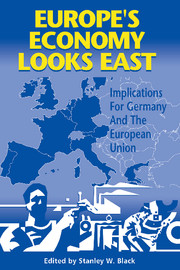Book contents
- Frontmatter
- Contents
- List of figures and tables
- Preface
- List of conference participants
- List of acronyms
- 1 Introduction
- I Trade relations
- 2 An economic assessment of the integration of Czechoslovakia, Hungary, and Poland into the European Union
- Comments
- 3 Potential trade with core and periphery: industry differences in trade patterns
- Comments
- 4 Impact on German trade of increased division of labor with Eastern Europe
- Comments
- II Investment patterns
- III Labor market issues
- IV The process of integration
- Index
2 - An economic assessment of the integration of Czechoslovakia, Hungary, and Poland into the European Union
Published online by Cambridge University Press: 03 February 2010
- Frontmatter
- Contents
- List of figures and tables
- Preface
- List of conference participants
- List of acronyms
- 1 Introduction
- I Trade relations
- 2 An economic assessment of the integration of Czechoslovakia, Hungary, and Poland into the European Union
- Comments
- 3 Potential trade with core and periphery: industry differences in trade patterns
- Comments
- 4 Impact on German trade of increased division of labor with Eastern Europe
- Comments
- II Investment patterns
- III Labor market issues
- IV The process of integration
- Index
Summary
Introduction
This paper is a study of the economic effects of the integration of the Central European Countries (CECs) into the European Union (EU). Our analysis of EU-CEC integration is based on a specially constructed version of the University of Michigan Computational General Equilibrium (CGE) Trade Model. We use this model to calculate the economic effects of EU-CEC integration on trade, output, and employment by sector as well as the real returns to capital and labor and the economic welfare of the CECs, the EU members, and the other major trading country aggregates included in the model.
Our study is distinctive in two respects. First, we bring together the elements of the EU assistance to the CECs and construct a Stylized European Agreement Package (SEAP), rather than analyzing them as separate initiatives for each CEC country. This provides a more synthesized account of the scope and magnitude of EU-CEC integration than has been previously available. Second, by using a CGE model to evaluate EU-CEC integration, our paper complements previous studies of the EU-CEC agreements that have considered: (1) the effects of the Europe agreements on EU-CEC trade (Winters and Wang, 1994); (2) the positive welfare effects of improved access to the EU markets for the CECs (Aghion et al., 1992); (3) the reaction of the EU to changes in the trade policies of the CECs (Messerlin, 1992); and (4) the potential CEC trade patterns as reflected within a gravity model framework (Baldwin, 1994).
- Type
- Chapter
- Information
- Europe's Economy Looks EastImplications for Germany and the European Union, pp. 23 - 60Publisher: Cambridge University PressPrint publication year: 1997
- 1
- Cited by



